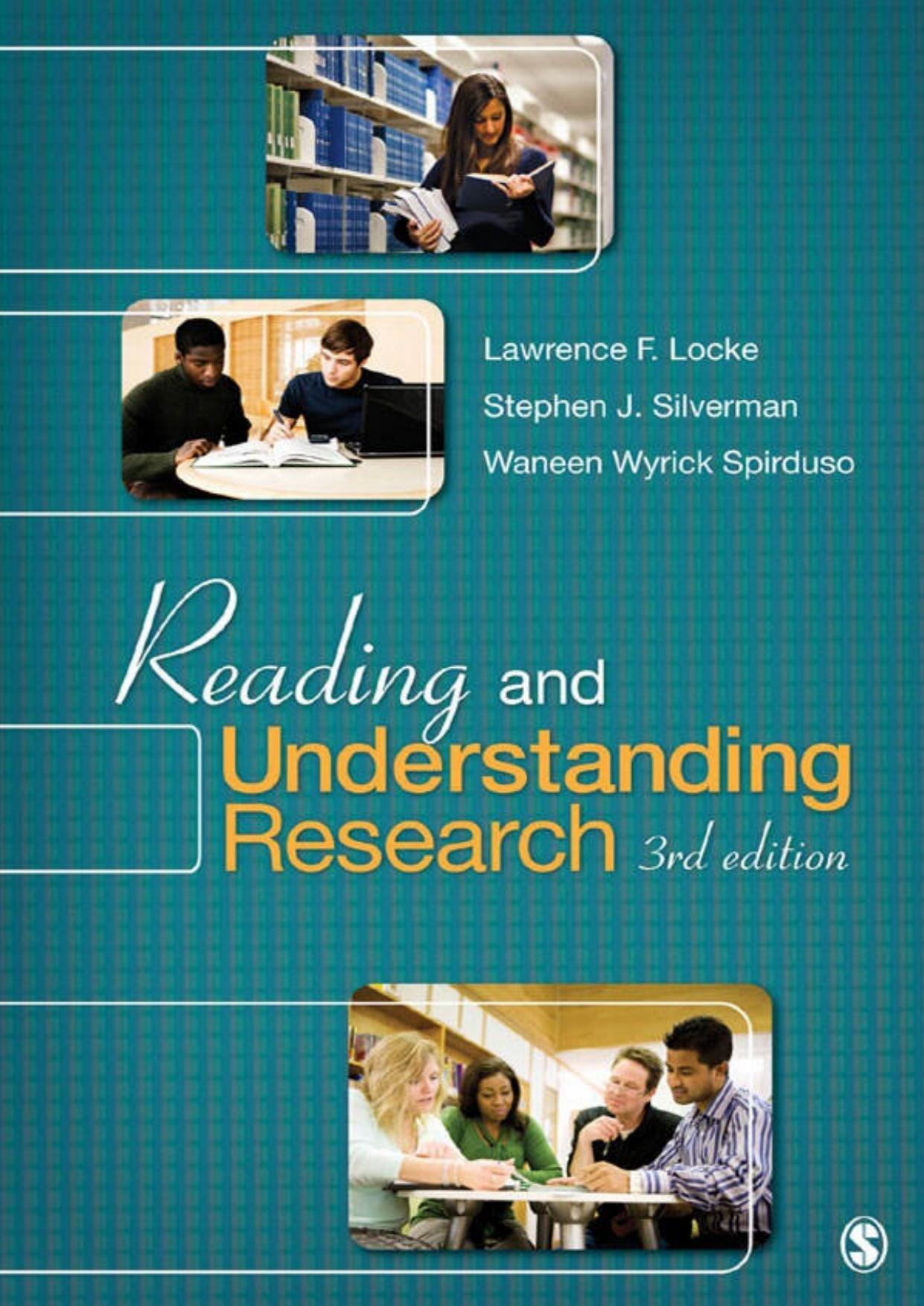Reading and Understanding Research 3rd edition by Lawrence Locke, Stephen Silverman, Waneen Spirduso ISBN 1412975742 9781412975742
$70.00 Original price was: $70.00.$35.00Current price is: $35.00.
Instant download Reading and Understanding Research 3rd Lawrence F. Locke & Stephen Silverman & Waneen W. Spirduso after payment
Reading and Understanding Research 3rd edition by Lawrence Locke, Stephen Silverman, Waneen Spirduso – Ebook PDF Instant Download/Delivery: 1412975742, 9781412975742
Full download Reading and Understanding Research 3rd edition after payment

Product details:
ISBN 10: 1412975742
ISBN 13: 9781412975742
Author: Lawrence Locke, Stephen Silverman, Waneen Spirduso
Ideal for students, novice researchers, or professionals, this indispensable resource serves as a road map for readers who need to analyze and apply research findings. It helps them think critically about the credibility of what they are reading by showing them how to identify problems and develop constructive questions. Key Features Assumes no prior knowledge of research procedures Provides readers with a step-by-step format for decoding the complex language and formats used in reports and reviews Includes the most common formats for both quantitative and qualitative inquiry Offers both illustrative examples and powerful training exercises Gives specific attention to strategies for critically appraising reported research Presents completely updated references as well as an annotated bibliography Intended Audience This text is appropriate for both upper-level undergraduate and graduate students across the social sciences enrolled in introductory research courses as well as students in professional preparation programs.
Reading and Understanding Research 3rd Table of contents:
PART I. THE NATURE AND USES OF RESEARCH REPORTS
1. The Research Report
Finding Valuables in Research Reports
Reading Reports: When to Do It
Reading Research: When to Consider Using Alternative Sources
Reading Research: What Can You Find Besides Findings?
What Is a Research Report?
Research Reports: A Middle-Ground Definition
What Fits Under the Umbrella?
About Publications
Criterial Characteristics: What Has to Be in a Report?
2. When to Believe What You Read: The Sources of Credibility
Who Does Research, and Where Do They Do It?
Who Does Research?
Where Do Researchers Do Their Work?
Believing What You Read in Research: The Foundations of Trust
The Review Process for Presenting and Publishing Research
Journal Selectivity
Reputation of the Author(s)
Source of Funding
Sponsorship by a Research or Professional Organization
Reasons to Suspend Trust in a Research Report
Technical Problems
Sampling
Lack of Replication
Conflicts
Carelessness
Errors and Poor Scholarship
Summary
Can Any Research Report Be Perfect?
3. How to Select and Read Research Reports
Getting Started: Selecting Research Reports
Looking for the Right Read
Reading Research Cooperatively
How to Read Research Reports
Researchers as Writers: Style and Substance
Researchers as Workers: The Matter of Respect
The Reader as Consumer: Burdens to Leave Behind
Reading Research as Puzzle Solving
Communication in Reports: It Takes Two to Tango
Graphic Tools: Most Travelers Need a Map
On Getting Hung Up: Do Not Get Stuck on the Wrong Things
The Limits of Respect: Healthy Skepticism
4. The Use, Misuse, and Misunderstanding of Research
Problems With Reports
Problems With Research
Summary
Note
5. Types of Research: An Overview of Variety
Generic Issues in Research
Types of Research
PART II. QUANTITATIVE RESEARCH
6. Quantitative Research Designs
Statistics in Quantitative Research
Types of Quantitative Research
Descriptive Research
Correlational Research
Quasi-experimental/Experimental Research
Single-Subject Research
Meta-analysis
7. Staying Organized When Reading a Quantitative Report
Reading and Recording From Quantitative Research Reports
Doing the 12-Step
Example of a Completed Quantitative 12-Step Form With Flowcharts
8. Explaining as a Tool for Learning to Read Reports
Teaching Is the Best Way to Learn
How to Give an Explanation: Rules of the Game
Formats for the Explanation: Pairs, Teams, and Solos
How to Give an Explanation: Handy Hints From Hard Experience
The Bad Explanation: Five Fatal Flaws
The Purpose of Explaining
9. Reading Reports of Quantitative Research—Critically: Things to Notice and Questions to Ask
Introduction: The Five Basic Questions
What Is the Report About?
How Does the Study Fit Into What Is Already Known?
How Was the Study Done?
What Was Found?
What Do the Results Mean?
Summary
PART III. QUALITATIVE RESEARCH
10. The Paradigms for Qualitative Research
Interpretive Research
Generic Studies
Phenomenological Studies
Ethnographic Studies
Grounded Theory Studies
Critical Research
Mixed Methods Research
Concluding Comments About Types of Research
11. Staying Organized When Reading a Qualitative Report
Identifying Qualitative Research Reports
A 12-Step Guide for Understanding Qualitative Research Reports
Example of a Completed Qualitative 12-Step Form With Flowcharts
12. Reading Reports of Qualitative Research—Critically: Things the Reader Should Expect
Expectations for Qualitative Reports: The Generic and General Standards
Expectations for Qualitative Reports: The Specific and Individual Standards
Expectations for Qualitative Studies: A Critical Look Behind the Report
The Machinery of Time
The Machinery of Subjectivity
The Machinery of What Does Not Fit
The Machinery of Relationships
The Machinery of Context
PART IV. READING RESEARCH REVIEWS
13. Staying Organized When Reading Research Reviews
A 12-Step Map for Reading Reviews
Navigating Through Reviews With Your 12-Step Map
Example of a Completed 12-Step Form for Reading Research Reviews
Concluding Remarks
Appendix A: Annotated Bibliography of Supplementary References
Appendix B: Statistics: A Beginner’s Guide
Descriptive Statistics
Statistical Probability
Differences Between Means
Association Statistics and Correlation
Closing Comments
References
Name Index
Subject Index
People also search for Reading and Understanding Research 3rd :
reading and understanding research 3rd edition pdf
reading and understanding research 3rd ed
reading recovery reading levels
what is reading and reading skills
3 benefits of reading
Tags: Lawrence Locke, Stephen Silverman, Waneen Spirduso, Understanding Research


